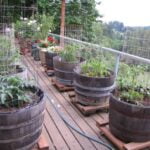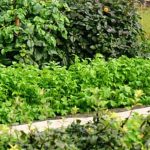Small vegetable gardens offer a multitude of benefits and are becoming increasingly popular, especially for those with limited space. In this article, we will explore the importance of small vegetable gardens and provide a comprehensive guide to help you create your own thriving garden oasis.
From selecting the right vegetables to maximizing space and caring for your plants, we will cover all aspects of small-scale gardening. By the end, you will be equipped with the knowledge and inspiration necessary to transform even the tiniest patch of land into a vibrant and bountiful vegetable haven.
The benefits of small vegetable gardens extend far beyond just having fresh produce at your fingertips. These compact green spaces offer a range of advantages that make them an attractive option for urban dwellers or those with limited outdoor space. Not only can they contribute to sustainability by reducing food miles and promoting self-sufficiency, but they also provide an opportunity for individuals to reconnect with nature and experience the joy of growing their own food.
Whether you have just a window sill, balcony, or a small backyard, there is always room for a small vegetable garden. With careful planning and creative techniques such as vertical gardening and container gardening, you can maximize even the smallest spaces. Join us as we delve deeper into the world of small vegetable gardens and discover how these pint-sized patches of greenery can bring immense beauty, health, and satisfaction into your life.
Location and Space
When it comes to creating a small vegetable garden, one of the most important factors to consider is the location and space. Choosing the right spot for your garden can greatly impact the success of your plants and ultimately determine the amount and quality of your harvest. Here are some tips to help you find the perfect spot for your small vegetable garden.
Firstly, it is essential to choose a location that receives an adequate amount of sunlight. Most vegetables require at least six hours of direct sunlight each day, so make sure to select an area that is not shaded by trees or buildings. If you have limited options for sunny spots in your yard, consider using raised beds or planters that can be moved around as needed to capture the most sunlight.
In addition to sunlight, it is also crucial to ensure that your chosen location has good soil quality and drainage. Vegetables thrive in well-drained soil that is rich in organic matter. Avoid areas with compacted or clayey soils as they can hinder root growth and lead to poor plant health. You may need to amend your soil with compost or other organic amendments to improve its fertility and structure.
Another factor to consider when selecting a location for your small vegetable garden is proximity to a water source. It is important to have easy access to water for regular irrigation, especially during dry periods. Consider placing your garden near a hose bib or installing a rain barrel if possible. Remember, consistent watering is crucial for healthy plant growth and high yields.
Finding enough space for your small vegetable garden can be challenging in urban environments or yards with limited square footage. However, there are many creative ways to maximize space even in cramped areas. Vertical gardening allows you to grow plants upward instead of spreading them out horizontally. Installing trellises, garden stakes, or using hanging baskets can help support climbing vegetables like tomatoes, cucumbers, beans, and peas, making the most out of limited space.
| Location and Space considerations | Tips |
|---|---|
| Sunlight | Choose a spot with at least six hours of direct sunlight per day. |
| Soil Quality | Select an area with well-drained soil that is rich in organic matter. Amend the soil if necessary. |
| Water Source | Avoid locations far from a water source. Consider placing your garden near a hose bib or using rain barrels for easy access to water. |
| Vertical Gardening | Maximize space by growing plants vertically using trellises, garden stakes, or hanging baskets. |
Choosing the Right Vegetables
Making the decision to start a small vegetable garden is an exciting one, but it’s important to choose the right vegetables that will thrive in limited space. When selecting plants for your small garden, there are several factors to consider such as the size of the plant, its growth habit, and its yield. By carefully choosing the right vegetables, you can maximize your harvest and make the most of your small garden.
Size and Space Considerations
One of the first things to consider when choosing vegetables for a small garden is their size. Some plants like corn or pumpkins can quickly take up a significant amount of space, making them unsuitable for small gardens. Instead, opt for vegetables that are compact and well-suited for container gardening or vertical gardening techniques. Look for varieties that have been specifically bred for small spaces or those that can be grown in hanging baskets or pots.
Fruitful Yields
Another important factor to consider is the yield of each vegetable you choose. Since space is limited in a small garden, you want your crops to be productive and provide a bountiful harvest. Vegetables like tomatoes, peppers, and beans tend to produce high yields in a limited area. Leafy greens such as lettuce or spinach are also great options as they can be harvested multiple times throughout the growing season.
Matching Growth Habits
It’s also crucial to select plants with compatible growth habits that will not compete with or overshadow each other in a confined space. Avoid planting tall vegetables like corn next to shorter ones that might be shaded out by their taller counterparts. Instead, choose vegetables that complement each other in terms of height and growth pattern. For example, grow vining plants like cucumbers or peas vertically on trellises so they won’t take up valuable ground space.
By carefully considering these factors when selecting plants for your small vegetable garden, you can ensure that your garden will be productive and efficient in its use of space. With the right combination of vegetables, your small garden can provide you with a satisfying and bountiful harvest throughout the growing season.
Vertical Gardening
When it comes to small vegetable gardens, maximizing space is crucial. One effective way of doing this is through vertical gardening. By utilizing trellises and hanging baskets, gardeners can take advantage of the vertical space available to grow a wider variety of vegetables.
Trellises
Trellises are a popular choice for vertical gardening as they provide support for vining plants such as tomatoes, cucumbers, beans, and peas. When selecting a trellis for your small vegetable garden, consider choosing one that is sturdy and made from materials like bamboo or metal. It’s important to install the trellis securely in the ground or attach it to a nearby structure to ensure stability.
When training your plants on the trellis, gently guide them towards the nearest support using garden ties or soft twine. Regularly check the growth of your plants and adjust their positioning if needed. Remember to keep an eye on their weight and size to prevent any damage or collapse of the trellis.
Hanging Baskets
Hanging baskets are another great option for maximizing space in small vegetable gardens, especially if you have limited ground space. They can be hung from fences, pergolas, or even balcony railings. When choosing hanging baskets, opt for ones with sufficient drainage holes to prevent waterlogged soil.
A variety of vegetables can be grown in hanging baskets including cherry tomatoes, herbs, lettuce, strawberries, and peppers. Choose compact varieties that won’t overwhelm the basket and consider mixing different plants together for an aesthetically pleasing display. Ensure that each plant has enough room for growth by spacing them out adequately within the basket.
Maintaining hanging baskets involves regular watering since they tend to dry out more quickly compared to traditional ground-grown plants. Keep in mind that they may also require additional fertilization due to the limited amount of available soil nutrients.
Vertical gardening with trellises and hanging baskets is a practical and space-efficient method for small vegetable gardens. With proper care and attention, gardeners can enjoy an abundance of fresh produce while making the most of their limited gardening area.
Container Gardening
Container gardening is a popular option for small vegetable gardens, as it allows you to grow a variety of vegetables even if you have limited space. This method involves using pots, planters, or raised beds to cultivate your plants. Not only does container gardening save space, but it also provides other benefits such as better control over the growing conditions and easy maintenance.
When choosing containers for your vegetable garden, make sure they are large enough to accommodate the root systems of your chosen plants. Pots should have drainage holes at the bottom to prevent waterlogging, which can lead to root rot. Raised beds are another excellent option for container gardening, especially if bending or kneeling is difficult for you. These elevated planters can be made from various materials such as wood, metal, or plastic.
To properly grow vegetables in containers, start by selecting vegetables that are well-suited for this method. Look for varieties that have compact growth habits or are specifically bred for container gardening. Some great choices include tomatoes, peppers, lettuce, spinach, carrots, radishes, and herbs like basil and parsley.
Proper care is vital when it comes to container gardening. Regular watering is crucial because containers tend to dry out more quickly than traditional garden beds. Monitor the moisture level by sticking your finger about an inch into the soil – if it feels dry at this depth, it’s time to water again.
Additionally, container-grown plants need regular fertilizing since the nutrients in their confined environment get depleted faster compared to in-ground plants. Use a balanced organic fertilizer or a slow-release formula specifically designed for vegetables.
Finally,% ensure proper pest control measures are taken It’s important to keep an eye out for common pests such as aphids or snails and address them promptly with natural pest control methods like neem oil or handpicking.
Companion Planting
Companion planting is a popular technique among gardeners, especially those with small vegetable gardens. This practice involves growing different plants together that benefit each other in some way, such as repelling pests, attracting beneficial insects, or providing shade and support. In small gardens where space is limited, companion planting can be a highly effective method to maximize yield and create a more productive and harmonious garden.
One common example of companion planting is the combination of tomatoes and basil. Tomatoes release chemicals into the soil that deter certain insect pests, while basil has strong aromatic oils that repel insects like flies and mosquitoes. By planting these two crops together, you not only save space but also naturally control pests without resorting to chemical pesticides.
Another example is the intercropping of corn, beans, and squash – known as the Three Sisters method. The corn provides vertical support for the climbing beans, while the beans fix nitrogen in the soil, benefiting both the corn and squash. The large leaves of the squash act as living mulch, suppressing weed growth and conserving moisture in the soil. Together, these three crops form a mutually beneficial partnership that maximizes productivity.
Incorporating companion planting into your small vegetable garden can be done through careful planning and research on plant compatibility. Consider factors such as plant height, growth habit, nutrient requirements, light needs, and susceptibility to diseases or pests. It’s also important to rotate crops each season to prevent nutrient depletion or disease build-up in the soil.
| Companion Plants | Benefit |
|---|---|
| Tomatoes & Basil | Natural insect repellents |
| Corn, Beans, & Squash | Support, nitrogen fixation, weed suppression |
| Carrots & Onions | Insect repellents and space-saving |
| Lettuce & Radishes | Shade protection and faster growth for radishes |
By implementing companion planting in your small vegetable garden, you can create a diverse and mutually beneficial ecosystem that maximizes the use of limited space. Not only will you enjoy higher yields and healthier plants, but you’ll also contribute to a more sustainable and environmentally-friendly gardening approach. So why not give companion planting a try and reap the rewards of an efficient and productive small garden?
Design and Layout
Creating an aesthetically pleasing design is just as important in small vegetable gardens as it is in larger ones. With limited space, it becomes even more crucial to maximize the visual appeal of your garden. Here are some tips for designing a visually appealing small vegetable garden:
- Utilize vertical gardening techniques: One way to create a visually appealing design in a small vegetable garden is by incorporating vertical gardening techniques. This involves using trellises, arbors, or stakes to train certain plants to grow vertically, such as climbing vegetables like beans or cucumbers. Not only does this save space, but it also adds height and interest to your garden.
- Use color and texture: Another way to create aesthetic appeal is by selecting vegetables that provide a variety of colors and textures. For example, you can choose colorful varieties of lettuce, tomatoes, peppers, or carrots that will add visual interest to your garden beds. Additionally, consider incorporating different foliage textures by mixing plants with different leaf shapes and sizes.
- Add decorative elements: To enhance the overall aesthetic appeal of your small vegetable garden, consider adding some decorative elements. This can include various non-edible plants such as flowers or ornamental grasses that complement the vegetables without competing with them for resources. Decorative containers or planters can also be used strategically throughout the garden to add visual interest.
- Create paths and borders: Designing clear pathways within your small vegetable garden not only creates ease of access but also adds structure and organization to the overall design. Consider using materials such as gravel, stepping stones, or woodchips to define these paths. Additionally, creating borders between different planting areas can help give a cohesive look to your garden while preventing plants from overcrowding each other.
By implementing these design strategies in your small vegetable garden, you can transform it into an aesthetically pleasing space that not only provides a bountiful harvest but also brings joy and beauty to your surroundings. Remember to experiment, have fun, and let your creativity shine as you design your own unique small vegetable garden oasis.
Caring for Your Small Vegetable Garden
Once you have set up your small vegetable garden, it is important to properly care for it to ensure healthy and productive plants. This section will provide valuable information on watering, fertilizing, and pest control techniques specifically tailored for small gardens.
Watering
Proper watering is crucial for the success of your small vegetable garden. Here are some guidelines to follow:
– Water the soil directly at the base of the plants to avoid wetting the leaves, which can lead to diseases.
– Deeply water the plants, ensuring that the water reaches their root systems.
– Check the moisture level of the soil regularly by sticking your finger about an inch into the ground. If it feels dry at this depth, it’s time to water again.
– Avoid overwatering as it can drown the plants or lead to root rot. It’s better to underwater slightly than overwater.
Fertilizing
To keep your vegetables healthy and thriving, they need proper nutrients. Here are some fertilizing tips for your small garden:
– Start by preparing nutrient-rich soil before planting. Add compost or well-rotted manure for organic matter.
– Use a balanced fertilizer that contains essential plant nutrients such as nitrogen (N), phosphorus (P), and potassium (K). Follow label instructions for application rates and frequency.
– Apply fertilizer evenly around the base of each plant and gently work it into the soil surface.
– Avoid over-fertilizing, as it can cause nutrient imbalances or burn roots. Always follow recommended dosage rates provided by the fertilizer manufacturer.
Pest Control
Preventing and managing pests is essential for protecting your vegetable garden from damage. Consider these strategies:
– Regularly inspect your plants for signs of pests such as chewed leaves or discolored foliage.
– Use natural pest control methods whenever possible, such as handpicking insects or introducing beneficial insects like ladybugs or praying mantises.
– Companion planting can also help repel pests. For example, marigolds planted among your vegetables can deter aphids and nematodes.
– Consider using organic pest control products if the problem becomes severe. These products are usually safe for both humans and the environment.
By following these watering, fertilizing, and pest control practices in your small vegetable garden, you will ensure healthy plants that produce abundant yields all season long.
Harvesting and Enjoying the Fruits of Your Labor
Once you have put in the hard work of planting and nurturing your small vegetable garden, it’s time to reap the rewards and enjoy the delicious fruits of your labor. Harvesting is an essential step in the gardening process, and with proper techniques, it can be both satisfying and successful in small gardens.
- Timing is crucial when it comes to harvesting vegetables in small gardens. Each type of vegetable has its own specific timeline for when it should be harvested. For example, tomatoes are best picked when they are fully ripe and have a deep color.
On the other hand, leafy greens like lettuce or spinach can be harvested at any stage of growth, depending on personal preference. It’s important to research and understand the optimal harvesting time for each vegetable you are growing to ensure maximum taste and nutritional value. - Proper handling is another key factor in successfully harvesting vegetables from your small garden. It’s vital to handle vegetables with care to prevent damage or bruising. Use garden scissors or a sharp knife rather than pulling or twisting vegetables out by hand, as this can harm both the plant and the delicate roots system underneath. Gently remove each vegetable from its stem or vine, making sure not to damage nearby plants or fruits.
- Storage is critical once you have harvested your vegetables from your small garden. Most vegetables taste their best when eaten fresh from the garden, but if you find yourself with an excess amount that cannot be consumed immediately, knowing how to store them properly will help prolong their freshness. Some vegetables, like lettuce or herbs, can be stored in airtight containers in the refrigerator for a few days.
Others may require blanching and freezing for long-term storage. Understanding the proper storage methods for each type of vegetable will ensure you can enjoy their flavors long after harvest.
Harvesting your homegrown vegetables from your small garden brings immense satisfaction and fulfillment that goes beyond just producing food. By following these tips for success in small gardens, you can make the most of your harvest and savor the rewards of your hard work. So get out there, pluck those ripe vegetables from their vines, and savor the freshness and flavors right in your own backyard.
Conclusion
In conclusion, small vegetable gardens offer a satisfying and sustainable solution for those with limited space. Despite their size, these gardens provide numerous benefits and play a vital role in promoting self-sufficiency, healthy eating habits, and environmental consciousness.
One of the main advantages of small vegetable gardens is their ability to bring fresh produce right to your doorstep. By growing your own vegetables, you can ensure that they are free from harmful pesticides and chemicals, while also enjoying the satisfaction of eating something you have cultivated with your own hands. This not only enhances the taste and nutritional value of your meals but also promotes a sense of connection to the food you consume.
Small vegetable gardens also contribute to sustainable living by reducing your carbon footprint. Growing your own food allows you to minimize transportation costs associated with store-bought produce, thereby reducing greenhouse gas emissions. Additionally, these gardens encourage composting and recycling practices by utilizing kitchen scraps as organic fertilizer. By implementing such practices in our homes, we can collectively work towards a greener future.
In conclusion, small vegetable gardens offer an array of benefits that make them an attractive option for individuals with limited space. From providing fresh homegrown produce to promoting sustainable living practices, these gardens allow us to connect with nature and lead healthier lives. So whether you have a small balcony or a tiny backyard, consider creating your own small vegetable garden and experience the joy and fulfillment it brings.

If you’re looking to get into vegetable gardening, or are just looking for some tips on how to make your current garden better, then you’ve come to the right place! My name is Ethel and I have been gardening for years. In this blog, I’m going to share with you some of my best tips on how to create a successful vegetable garden.





